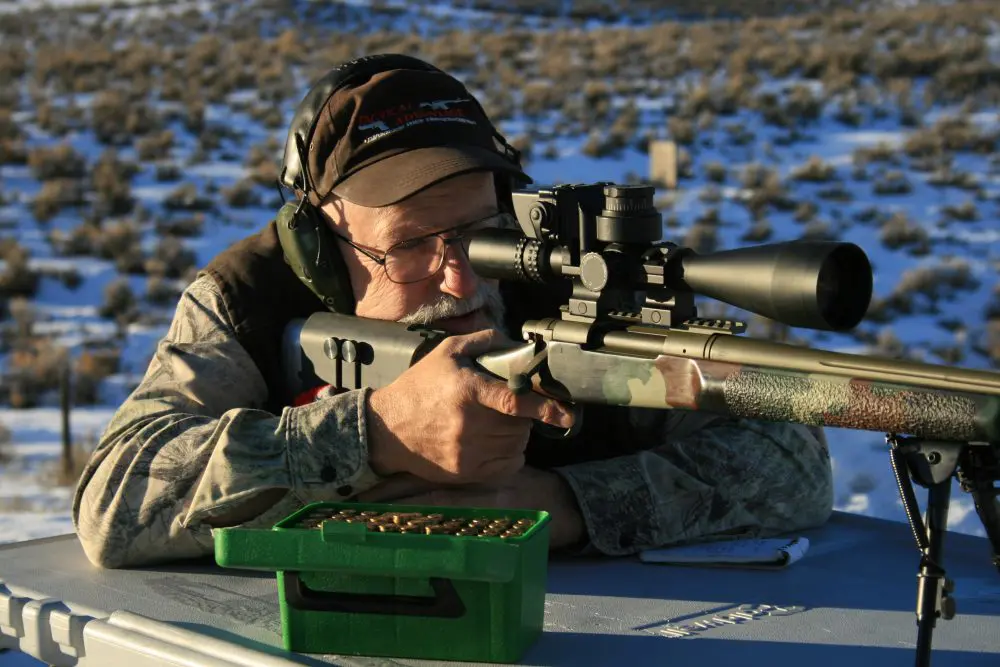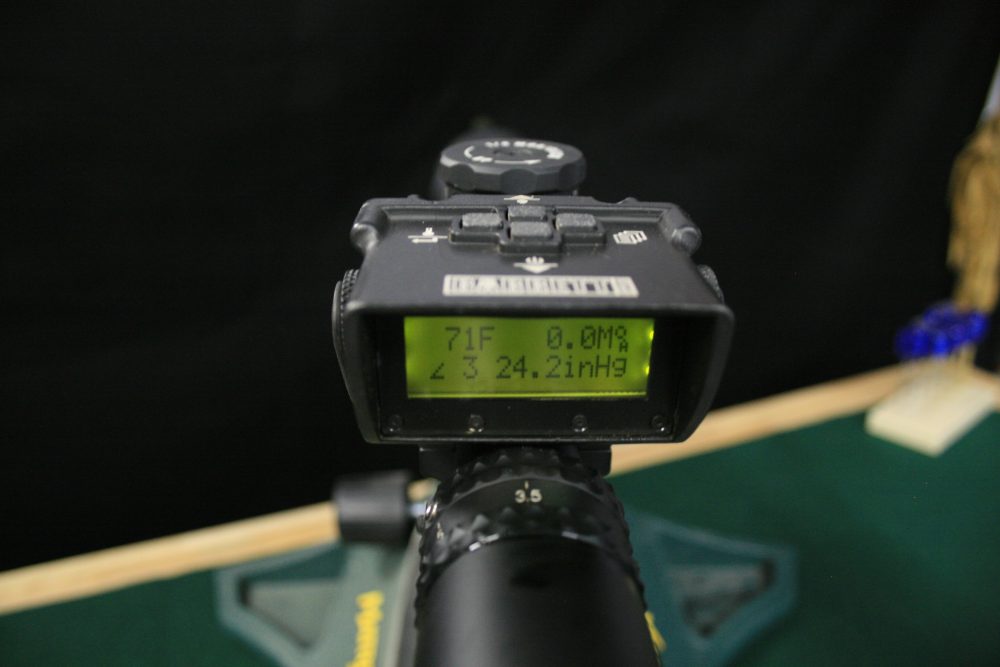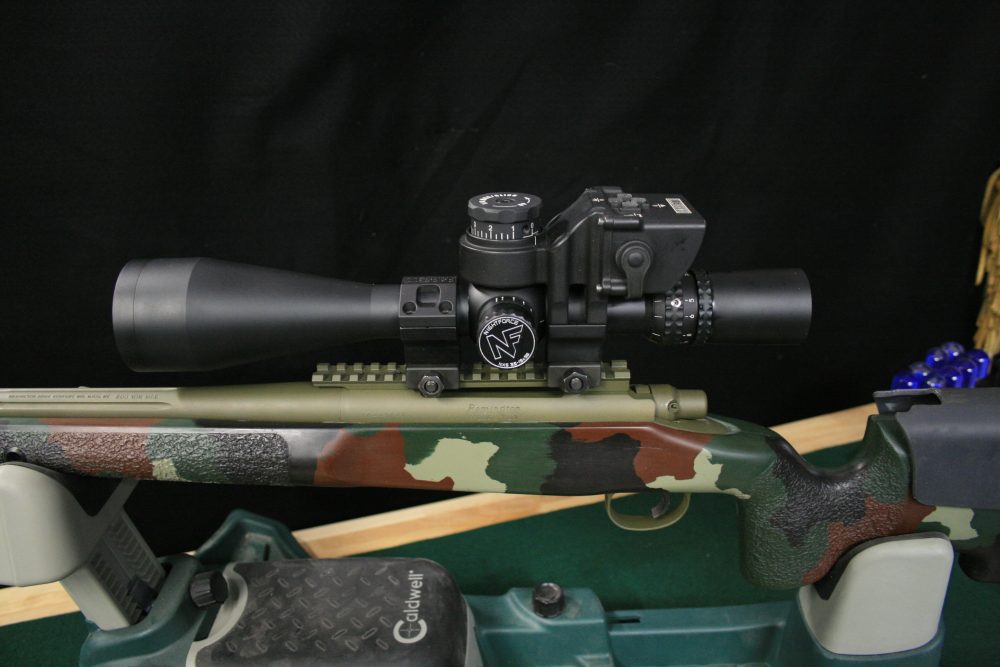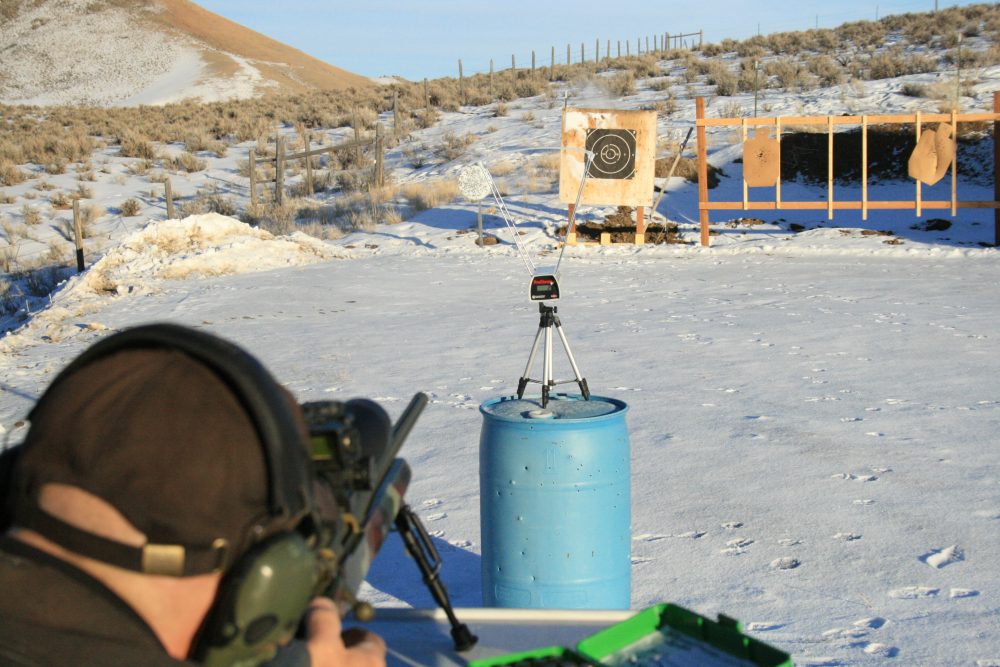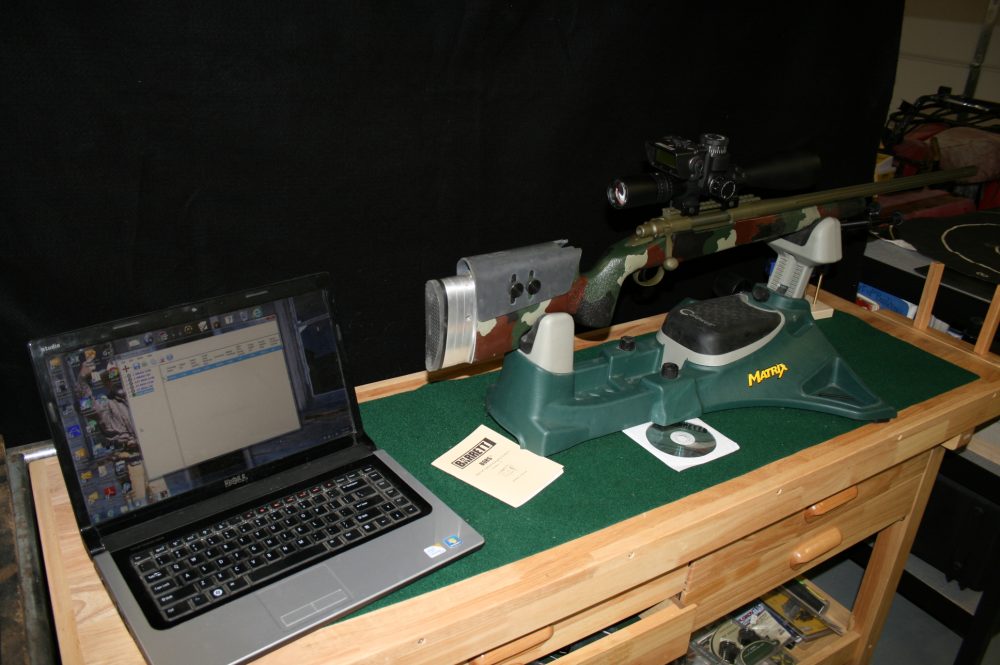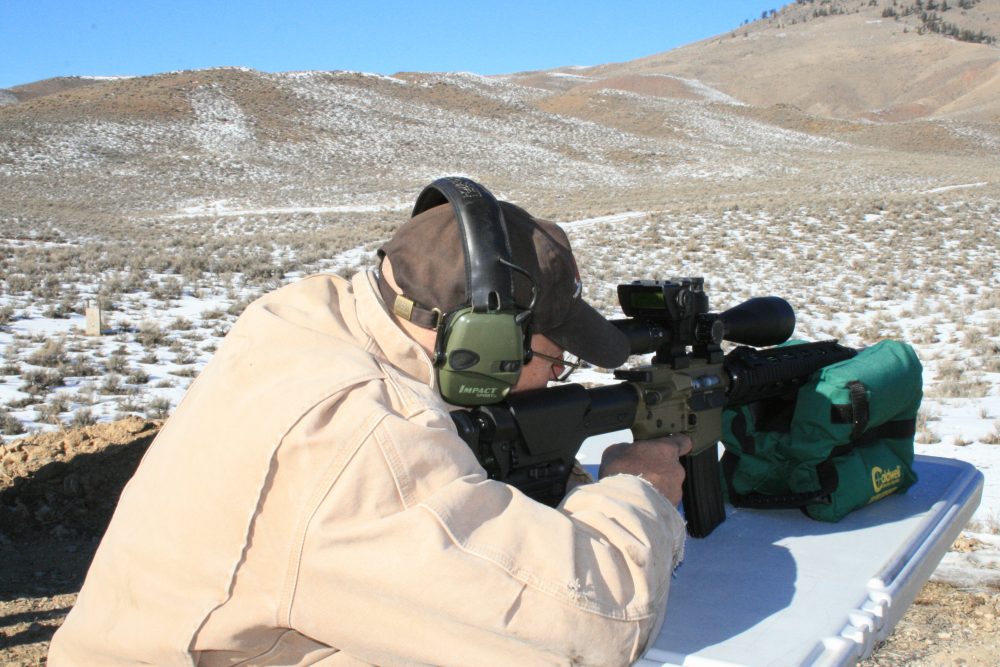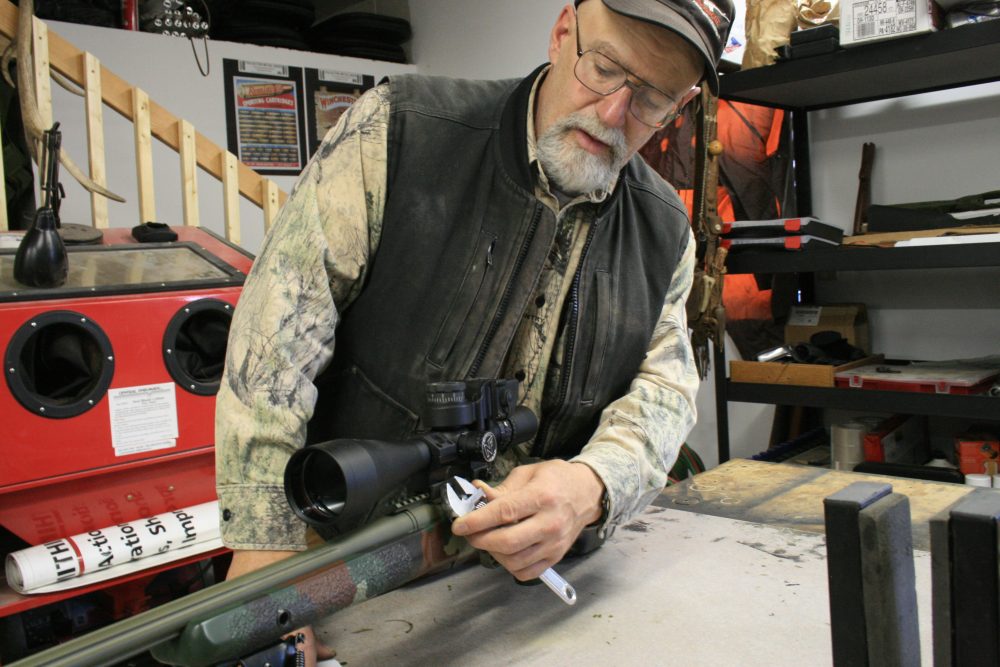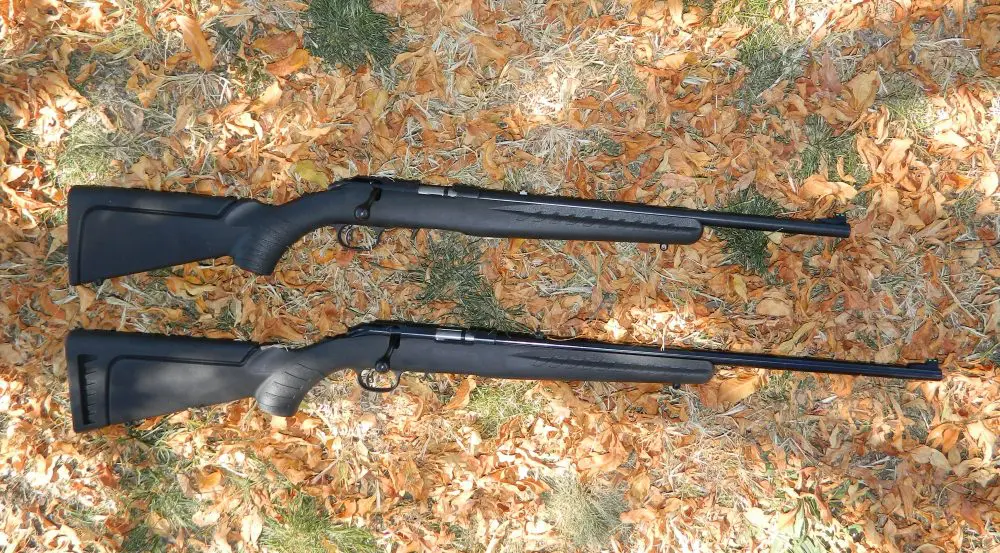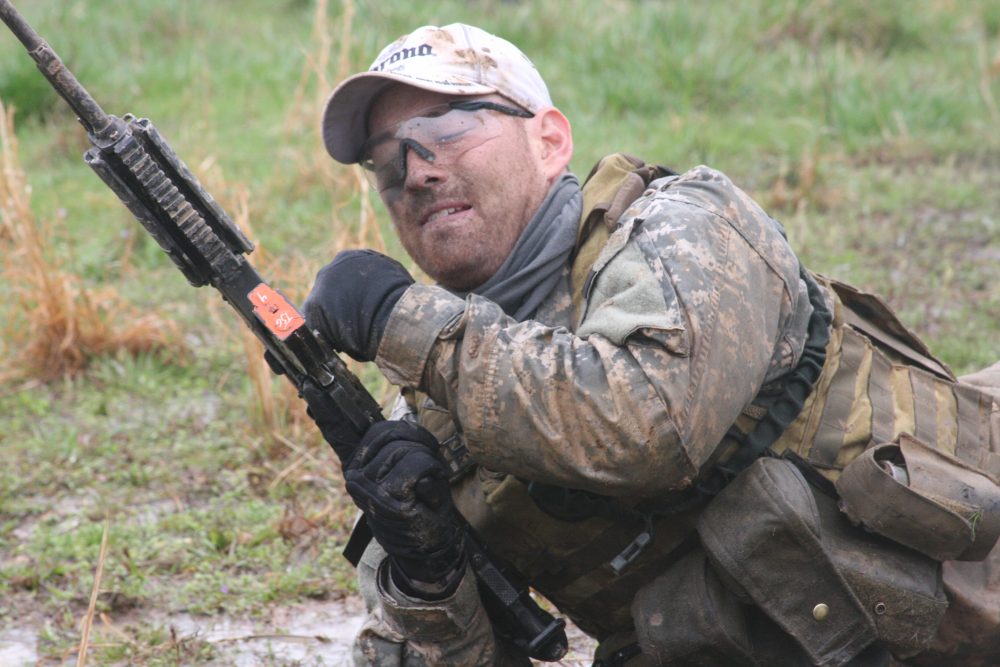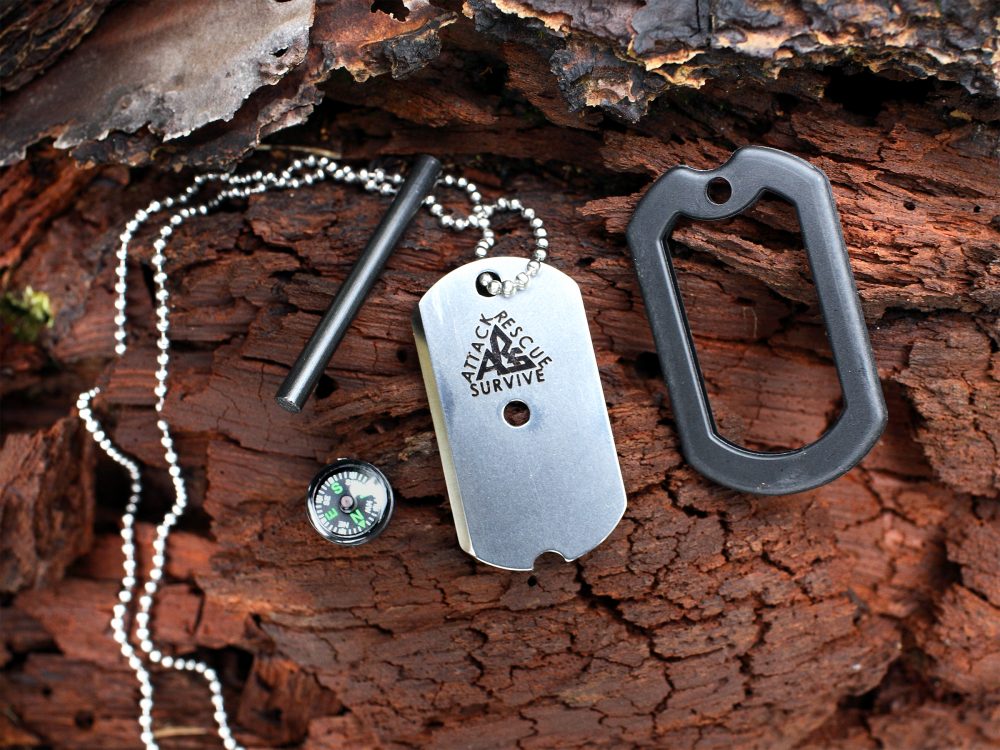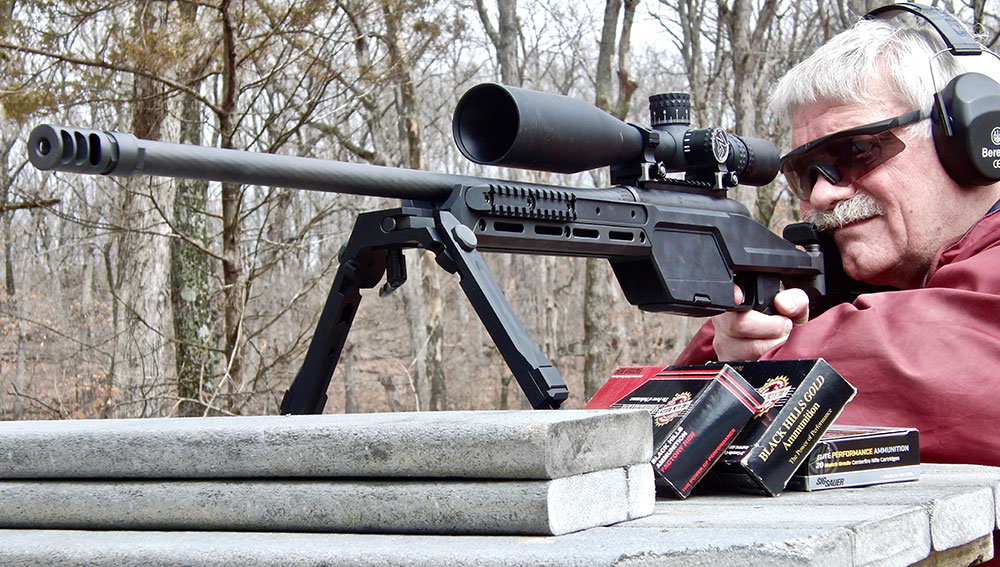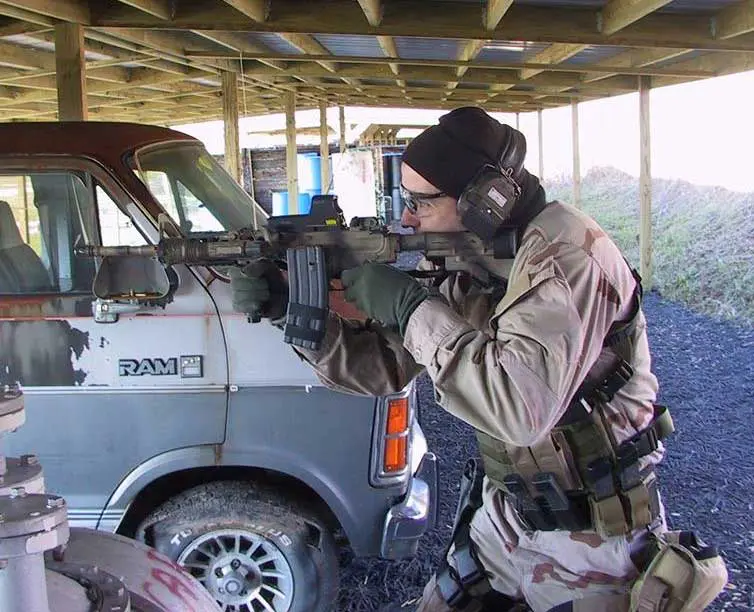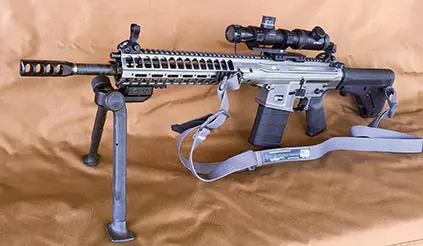Long before the measuring tools we now take for granted existed, shooters calculated things like distance and wind speed by the school of last experience. Two hundred yards last time looks like this and the bullet struck here. The wind speed on my face or vegetation caused my bullet to do this last time, so here’s my correction.
Through practice throwing lead downrange we learned first-hand what the elements caused the bullet to do. As measuring tools developed and became affordable, shooters had precise calculations of varying conditions that affected bullet flight.
In our quest for the rifle and scope that will calculate everything, including the bad guy’s intentions, we have reached the stage where the scope has a little brain right on it, measures many of the varying conditions, and then compensates for them when the elevation adjustment is made.
Weather screen showing reads for environmental conditions (in my shop).
Table of Contents
BARRETT OPTICAL RANGING SCOPE
Barrett has been making the Barrett Optical Ranging Scope (BORS) since 2008. As with all the products Barrett produces, innovation and improvement are ongoing, and the 2014 BORS does more for the shooter than its predecessor.
Unlike the independent PDA (Personal D.O.P.E. Advisor) or laptop we use to calculate all the data we need for the shot, the BORS mounts directly to the scope and, via direct attachment with the elevation knob, it can interact with the scope by turning the knob until the range appears on the LCD screen. The computer will automatically account for temperature, pressure and inclination and relate that information to the ballistic table pre-fed into the computer.
The unit holds 80 ballistic tables, so the shooter can have several loads for one caliber, different calibers or rifles, and the scope can be changed to another rifle by loosening the nuts and moving it. Just select the load in the data bank for the rifle and the BORS will do the rest.
BORS and Nightforce scope mounted on .300 Winchester Magnum. Scope and computer are not so large as to be cumbersome.
The BORS will mount to either a Leupold Mark 4 or Nightforce scope. I have worked with both scopes and their quality is professional grade—rugged and built for hard use on the battlefield. I have used both for years and they have so far proven to be Morelli-proof. The BORS is designed to withstand military operations, so wisdom would be to put it on one of these tough scopes.The BORS I tested was on a Nightforce scope.
The cost of a BORS/Nightforce scope could stagger most of us, but depending on how many rifles you shoot, it could be the cheapest quality combo in your arsenal. Since the BORS has capacity for 80 ballistic programs to be downloaded, there is enough space to have several loads for each rifle. The quick mount system allows it to be moved from rifle to rifle, and a quick selection of the new rifle’s load will direct the BORS to compute the data to the different rifle.
If you own five rifles, the system can be moved from rifle to rifle, allowing you to have extreme quality on each for several hundred dollars less than the price of either the BORS or the scope you put it on. The more rifles you own, the cheaper the system becomes per rifle. That philosophy might even work with the wife for buying another rifle.
Average muzzle velocity needs to be established so all other trajectories can be calculated.
TEST RIFLES AND ENVIRONMENTAL CONDITIONS
I started out the evaluation on a .300 Winchester Magnum. My rifle started life as a Remington Sendero, but has been super tuned for accuracy and sets inside a McMillan A-5 pillar bed stock. The rifle puts a 200-grain Sierra HPBT out the dangerous end at 2,855 feet-per-second (fps) at an altitude of 6,000 feet.
I also tested the BORS on a .223 Remington in an AR Varmint configuration because it is at the other end of the spectrum.
This system is most often seen on long-range big-bore guns like the .50 BMG or similar rifle. The fact is it can be used with any rifle from .22 up. The ballistic tables calculate the trajectory and the BORS compensates for the change in weather conditions.
While working with this system, I experienced drastic temperature changes. In mid-January, it is normally cold where I live, but this year it was cold at night and warmed up during the day. I sighted the rifle in at 20 degrees and have been shooting at different times during the day in temperatures as high as 40.
The humidity had been fluctuating also, although the altitude did not change. The BORS also compensates for altitude, since a fluctuation of 1,000 feet or more will usually make a drastic difference, especially at longer ranges.
Sighting in BORS/scope combination at 100 yards.
CONTROLS AND FUNCTIONS
The sample I was sent to work with had the BORS already mounted to the scope. It’s an easy process as the elevation knob is replaced with the elevation turret on the BORS. The rest of the unit is part of the rear scope ring and mount, while the front scope mount is independent.
The unit isn’t all that heavy or bulky and really doesn’t add much inconvenience to the rifle/scope combo. The controls are on top and accessible without breaking the shooting position.
One of the main differences between the BORS and an independent ballistic computer is that many of the compensations you feed into the PDA type computer give you a correction in MOA or MILS for you to adjust your elevation knob.
The BORS automatically does the adjusting for you when you change the elevation. It will sense the temperature, barometric pressure, and inclination the rifle is pointed at and figures it in as the shooter adjusts the elevation turret. This makes arriving at the shooting solution much quicker.
Mounting the BORS to my .300 Winchester Magnum, the scope rings mounted right to the Picatinny base. With the base of the scope rings, it was two inches above the center of the bore, giving plenty of clearance for the 50mm objective above the barrel.
Software is loaded into the laptop and information put in to develop the ballistic table. Library of ballistic tables can then be downloaded into the BORS.
I found the buttons on the top of the BORS were set up in a way that it was easy to work them to get what I wanted out of the unit. If you are recording your data, a screen tells you all the weather conditions.
There is a function to feed in wind info and it will compute the correction. This can be corrected as hold over or adjusted with the windage turret. The shooter still has to read the wind at the rifle and downrange and figure the wind value.
Wind value is the angle that the wind is hitting the traveling bullet. If it’s hitting it at 90 degrees to the path of the bullet, it’s considered full value wind. If it’s 45 degrees to the bullet path, it’s half value. The BORS uses a clock face to describe the wind value and direction, and the shooter just puts in the number of the wind direction and speed. The BORS gives the shooter the solution to correct the windage. It corrects to the range selected on the screen.
I spent some time playing with it and found it very easy to use. Over the several days that I worked with the BORS, it was unusually calm, and I didn’t need to compensate for wind.
BORS was comfortable on the AR platform, accurately reading and correcting for a variety of ranges.
ZEROING AND PROGRAMMING
After mounting the scope, I zeroed the rifle at 100 yards. There is a function in the BORS to zero the rifle at other distances if you prefer, such as 300 yards. Then the computer is set for that cartridge at the zero range. I made sure the rifle was zeroed precisely on the X at 100 yards, as I was planning on shooting at 1,000 yards, and a little off at 100 usually means off by enough to miss at 1,000.
The temperature was 20 degrees F when I zeroed the rifle.
The BORS comes with 80 common bullets and loads already uploaded in it. The shooter can customize a load and put the particulars on a program in their laptop and have the exact information for that load in the BORS. The program comes on a disk that is uploaded onto a computer and it downloads any new tables with the provided cable.
I fed in the info for the .300 Winchester Magnum that I handload, and it developed a table for the load. Like any other ballistic program, I fed in ballistic coefficient, bullet weight, distance between scope and bore, and a very precise measure of velocity. I printed it out for reference, but by putting it right into the BORS, all the environmental conditions will be accounted for when I set the range for the shot.
PUTTING THE BORS TO WORK
A day or so later, the temperature was in the 40s and I shot the 300-yard gong. The first shot was one inch to the left of my aiming point, but elevation was right on. I wrote off the left windage as a slight breeze that I didn’t correct for this test. The second shot at the gong splashed right over the first shot. The elevation correction was precisely correct though.
The next shot was on a ten-inch diameter rock at 584 yards. I was ranging the targets with a Leica Rangefinder. If you know the size of the target, the BORS ranges the targets for you using the ranging screen.
I was making gravel on a hillside of white rocks adjusting from 550 to 650 yards, with many of them down to the yard. The 584-yard rock telegraphed the hit with a smack that was nearly as loud as the report of the rifle. I did a kind of long-range plinking game on the hill of rocks, making first-round hits on each of them at varying distances. All I did on the BORS was turn the elevation turret until the yardage I was shooting at appeared in the screen. It really was a lot of fun.
The next target was 1,060 yards at a slight up angle. The Leica Rangefinder marked it as five degrees. With the BORS I didn’t even have to think about it or figure it in. I ranged the target and, when the rifle was set and the hairs on the mark, it read and compensated for the inclination.
At this range, Mother Nature kindly provided a tombstone-shaped rock that I can see hits on. I started there to see if the BORS put me on center. I continued my game of making gravel on the smaller rocks around the tombstone. If I did my part, the BORS gave me the proper correction and another rock sounded a hit.
These rocks were quite accommodating, marking the hit with a white puff that could be seen by the spotter. With the BORS, all the data we previously had to store in our heads or on range cards is now in the scope, or more correctly in the ballistic computer attached to the scope, and is accessed by adjusting the elevation turret. It’s the DOPE in the scope instead of the dope behind the scope.
BORS easily mounted to a rail base on the rifle.
AR’S TURN
I set the BORS up on an AR chambered for .223 Remington and fed the load info into it. This AR was set up for varmint hunting, specifically coyotes, and was very accurate at longer ranges. I started again with the 300-yard gong.
As with the .300 Winchester Magnum, hits were effortless and changing ranges as easy as turning the dial. The .223 didn’t make gravel as fast as the .300, but it was a lot of fun making hits at varying ranges.
The BORS is definitely the right direction for long-range shooters. It automatically takes into account the environmental factors”while adjusting for the range on the turret.
Much like the rangefinder has taken the guesswork out of estimating range, the BORS is a ballistic computer that corrects for the environmental conditions right at the time of the shot.
SOURCES:
Barrett Firearms
(615) 896-2938
www.barrett.net
Leupold & Stevens, Inc.
(503) 526-1400
www.leupold.com
Nightforce USA, Inc.
(208) 476-9814
www.nightforceoptics.com
